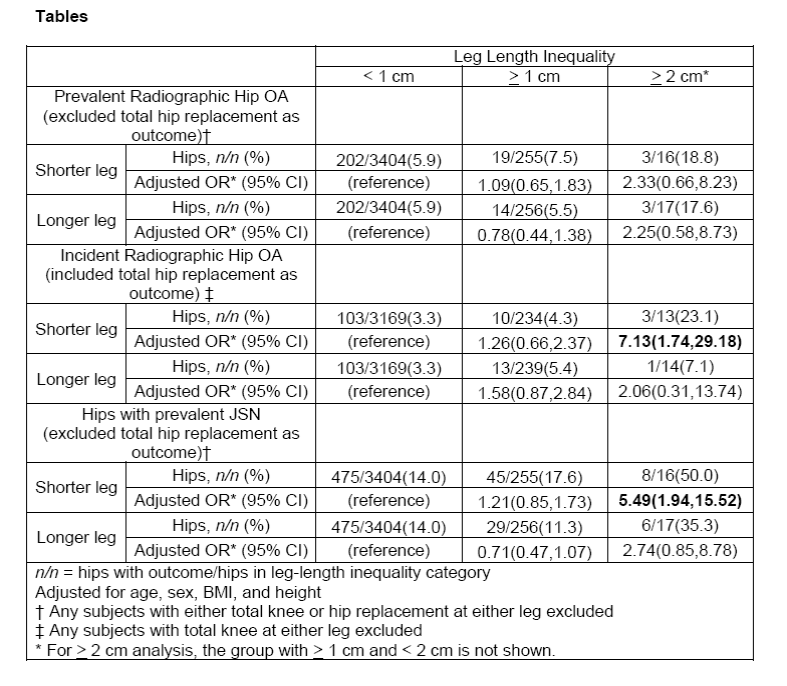Session Information
Session Type: Abstract Submissions (ACR)
Background/Purpose
Leg length inequality (LLI), a side-to-side difference in lower limb lengths, is common. In the Multicenter Osteoarthritis Study (MOST), in persons with LLI, the shorter limb was found to have an increased incidence, prevalence and progression of knee osteoarthritis (OA) compared to the longer limb. The shorter leg is likely to sustain increased impact force of the foot during gait thus transmitting a greater impulse up the ipsilateral leg. LLI is easily treatable and therefore could be a potentially modifiable risk factor for disease. However, the association of LLI and hip OA has not been prospectively studied. Therefore, we examined the association of LLI with hip OA in the MOST cohort.
Methods
The MOST cohort is a multicenter, longitudinal community based study of 3026 recruited for studying knee OA. Long limb films were obtained at baseline and 60 months, which were used to assess LLI and radiographic hip OA. Radiographic measurement of LLI is the gold standard measure. We defined LLI ≥ 1 cm based on previous literature, but we also assessed LLI ≥ 2 cm.
Radiographic hip OA was defined using UCSF criteria. Hips with prevalent JSN were defined as hips with any JSN at either superolateral or superomedial joint space at baseline. Hips with progressive JSN were defined as any with worsening JSN at 60 month follow-up. Associations between LLI and radiographic hip OA were assessed using logistic regression models with generalized estimating equations.
First, we examined cross-sectional baseline data. Because LLI may be generated by the existence of unilateral hip OA (which may slightly shorten the limb), we examined the longitudinal relationship of baseline LLI with incident hip OA and progressive JSN.
Results
Of the 3026 subjects, 125 subjects with either knee or hip replacements at baseline were excluded. Then, 55 subjects with missing LLI measurements were excluded (mostly due to poor quality films). We used radiographic OA data on both hips for all subjects, but for 17 subjects who had missing OA status for one hip, the contralateral hip was used in analyses. At baseline, neither LLI ≥ 1 cm nor 2 cm were associated with prevalent radiographic hip OA. In the longitudinal analyses, LLI ≥ 1 cm was not associated with incident radiographic hip OA. However, LLI ≥ 2 cm was associated with increased risk of incident radiographic hip OA (adjusted OR 7.13 [CI 95% 1.74,29.18]) for the shorter leg, but this was based on a small number in the group with LLI ≥ 2 cm (13 hips). LLI ≥ 2 cm increased risk for prevalent ipsilateral JSN (adjusted OR 5.49 [CI 95% 1.94,15.52]), LLI did not increase risk for progressive JSN (not shown).
Conclusion
LLI ≥ 1 cm was not associated with prevalent or incident radiographic hip OA or prevalent or progressive JSN. Although the sample size was small, LLI ≥ 2 cm was associated with increased risk for incident radiographic hip OA in the shorter leg and prevalent JSN in the shorter leg.
Disclosure:
C. Kim,
None;
J. Niu,
None;
M. Clancy,
None;
A. Guermazi,
None;
M. C. Nevitt,
None;
N. A. Segal,
None;
W. F. Harvey,
None;
C. E. Lewis,
None;
D. T. Felson,
None.
« Back to 2014 ACR/ARHP Annual Meeting
ACR Meeting Abstracts - https://acrabstracts.org/abstract/leg-length-inequality-and-hip-osteoarthritis/

